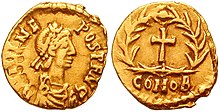Tremissis
The tremissis (plural: tremisses ) is a late antique gold coin of the Roman Empire and its subsequent empires. The tremissis was the third coin (hence the name) of the standard solidus gold coin and initially consisted of 1.51 grams of pure gold (equivalent to 24 carats ). This coin was very widespread throughout Europe and the Mediterranean region, particularly in the 5th and 6th centuries, and was probably the most common coin at the time.
Roman Empire
The tremissis was introduced by Emperor Valentinian I during his reign in the years 364–375; Coinings are documented for the first time from the year 383 (possibly not until 384) by Emperor Magnus Maximus (383–388). From the beginning of the 5th century, the tremissis was issued in very large quantities by the imperial mints and established itself as the most common coin. During the whole time the gold content of the coin and thus the value of the coin remained constant.
Eastern Roman Empire / Byzantium
After the fall of the Western Roman Empire in 476, the Eastern Roman emperors in Byzantium took over the leadership in minting and continued to produce tremisses in their mints with newly mined gold, but from Emperor Justin I (reign 518-527) onwards they were more and more suitable in design more by replacing imperial symbols with Christian symbols of the advancing Christianization. Due to the constant instability of their coin system and driven by a lack of money, lighter tremisses were minted from the reign of Emperor Justinian I (in the years 527-565), which were one carat lighter (thus only consisted of 1.45 grams of pure gold) and accordingly were marked. From the year 580 on, there was a general change in the coin weights, the tremissis now consisted of only 20 carat gold (1.26 grams of pure gold), followed by a gradual deterioration in the gold content of the coins. Due to the deterioration in the gold content, the tremissis lost its value, but was still minted until the 9th century. The last minting of a tremissis in Constantinople took place under Emperor Michael I (811 to 813) and in Syracuse under Emperor Basil I (867 to 886).
Pseudo-imperial
After the fall of the Western Roman Empire , the kings of the subsequent empires (such as the Merovingians , Vandals , Ostrogoths , Visigoths , Burgundians , Lombards and the Anglo-Saxons ) took over the Roman coin system and continued it in their empires. Thus, coinage of the tremissis based on the Byzantine model was created, in which Byzantine coins including the design in the representation of the emperors were copied. These coins are therefore called pseudo-imperial; the gold for these coins came from the existing gold reserves ; no new gold was mined. The Merovingians dispensed with the separate marking of the coins, while the other kingdoms marked these coins as minted by them. Individual kings (such as Theudebert I ) began to have tremisses minted with their own likeness, but this did not prevail. The tremissis continued to exist as a universal coin in the entire former Roman Empire.
In these domains there are no known types of slight tremiss as in Byzantium. Nevertheless, the remaining empires followed the decline in the value of coins from Byzantium from the year 580; The Merovingians also begin to circulate tremisses in their sphere of rule by mint masters and clearly marked as produced by such. Parallel to the deterioration in Byzantium, the gold content in the coins decreased in the 7th century, so that the tremissis also lost value here. From the year 660 onwards, the tremissis, like the solidus, was replaced by a silver currency and displaced.
numismatics
In numismatics, the tremissis is often referred to as triens . However, the triens is a republican Roman coin and has no connection whatsoever to the tremissis. In the Latin, used by Gregory of Tours in the Ten Books on the History of the Franks , the tremisses are also referred to as "treantes" .
literature
- Ursula Kampmann, The coins of the Roman Empire, Battenberg Verlag Regenstauf, 1st edition 2004, ISBN 3-89441-549-5
- Andreas Urs Sommer , The coins of the Byzantine Empire 491–1453. With an appendix: The coins of the kingdom of Trebizond. 534 pages. Regenstauf: Battenberg Verlag, 2010, ISBN 978-3-8664-6061-4
- Philip David Whitting: Coins of Byzantium, Friborg 1973
- Philip Grierson , Mark Blackburn : Medivial European Coinage vol. 1, The Early Middle Ages; Cambridge 1986. ISBN 978-0-521-26009-1
- David R. Sear, Byzantine Coins and Their Values, 1987, ISBN 0-7134-7740-7
Web links
Individual evidence
- ^ Constantina Katsari: The Roman Monetary System, The Eastern Provinces from the First to the Third Century AD; Cambridge 2011. page 177. ISBN 978-0-5217-6946-4
- ↑ Adriano Savio: Monete Fiction; Rome 2001. Page 236. ISBN 978-8878012912
- ↑ Ursula Kampmann, The Coins of the Roman Empire, Battenberg Verlag Regenstauf, 1st edition 2004, page 19
- ↑ Philip Grierson, Mark Blackburn: Medivial European Coinage vol. 1, The Early Middle Ages; Cambridge 1986. page 11
- ^ Andreas Urs Sommer , The Coins of the Byzantine Empire 491-1453. With an appendix: The coins of the kingdom of Trebizond. Regenstauf: Battenberg Verlag, 2010, page 15
- ↑ David R. Sear, Byzantine Coins and Their Values, 1987; see there No. 1615A and No. 1716
- ↑ Philip Grierson, Mark Blackburn: Medivial European Coinage vol. 1, The Early Middle Ages; Cambridge 1986. page 116
- ↑ here: Gregory of Tours, Historiarum Francorum Libri X, Book III, Chapter 13: “… singulos treantes dare in redemptionem suam” .


